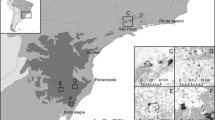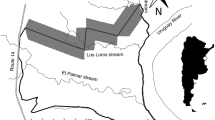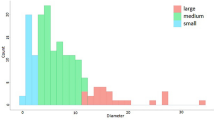Abstract
The endozoochorous and epizoochorous dispersal of vascular plant species by roe deer (Capreolus capreolus) and wild boar (Sus scrofa) was investigated in forest areas of Schleswig-Holstein and Lower Saxony, Germany. The primary aim of this study was to learn about which plant species and in what numbers diaspores are dispersed by the two wild ungulate species. In particular, the significance of zoochory for species composition and biodiversity of forests was evaluated. Fresh faecal pellets were collected from April–November 2001 in the forests of the two study areas. In addition, the coats and hooves of shot roe deer and wild boar were brushed out. The number of viable seeds was determined by greenhouse germination (seedling emergence method). The samples were spread in trays over sterilized soil from the study forests and were kept under controlled conditions in the greenhouse for 12 months. A total of 2,473 individuals from 77 vascular plant species were recorded. While roe deer exceeded wild boar concerning seed contents in the faeces, the significance of roe deer for epizoochorous dispersal was relatively low compared with wild boar. An analysis of the habitat preference of the vascular plant species dispersed by the two ungulate species revealed a high proportion of species growing in forests as well as in the open landscape, and also of non-forest species, while woody plants and herbaceous species closely tied to forest habitats were severely underrepresented. We also discuss consequences for forest ecology and nature conservation.







Similar content being viewed by others
References
Behrend A (1999) Kinetik des Ingestaflusses bei Rehen (Capreolus capreolus) und Mufflons (Ovis ammon musimon) im saisonalen Verlauf. Diss Humboldt-Universität, Berlin
BMVEL: Bundesministerium für Verbraucherschutz, Ernährung und Landwirtschaft (Hrsg) (2001) Die biologische Vielfalt des Waldes. Ihre Erhaltung und nachhaltige Nutzung. Bundesministerium für Verbraucherschutz, Ernährung und Landwirtschaft, Bonn
Boeker P (1959) Samenauflauf aus Mist und Erde von Triebwegen und Ruheplätzen. Z Acker-Pflanzenbau 108:77–92
Bonn S, Poschlod P (1998) Ausbreitungsbiologie der Pflanzen Mitteleuropas. Quelle und Meyer, Wiesbaden
Briedermann L (1990) Schwarzwild, 2nd edn. VEB Landwirtschaftsverlag, Berlin
Ellenberg H Jr (1974) Beiträge zur Ökologie des Rehes (Capreolus capreolus L. 1758). Daten aus den Stammhamer Versuchsgehegen. Diss, Kiel
Ellenberg H Jr (1978) Zur Populationsökologie des Rehes (Capreolus capreolus L., Cervidae) in Mitteleuropa. Spixiana Suppl 2:1–211
Ellenberg H Jr (1988) Eutrophierung—Veränderungen der Waldvegetation—Folgen für den Reh-Wildverbiss und dessen Rückwirkungen auf die Vegetation. Schweiz Z Forstwes 139:261–282
Fischer A (2000) Der Einfluss des Schalenwildes auf die Bodenvegetation—ein Beitrag zur Leitbildentwicklung für das Wildtiermanagement aus vegetationsökologischer Sicht. Ber Freiburger Forstl Forsch 17:81–93
Fischer S, Poschlod P, Beinlich B (1996) Experimental studies on the dispersal of plants and animals on sheep in calcareous grasslands. J Appl Ecol 33:1206–1222
Gill RM, Beardall V (2001) The impact of deer on woodlands: the effects of browsing and seed dispersal on vegetation structure and composition. Forestry 74:209–218
Hahn N (2002) Raumnutzung und Ernährung von Schwarzwild. LWF Aktuell 35:32–34
Heinken T, Hanspach H, Schaumann F (2001a) Welche Rolle spielt die endozoochore Ausbreitung von Pflanzen durch wildlebende Säugetiere? Untersuchungen in zwei brandenburgischen Waldgebieten. Hercynia 34:237–259
Heinken T, Lees D, Raudnitschka D, Runge S (2001b) Epizoochorous dispersal of bryophyte stem fragments by roe deer (Capreolus capreolus) and wild boar (Sus scrofa). J Bryol 23:293–300
Heinken T, Raudnitschka D (2002) Do wild ungulates contribute to the dispersal of vascular plants in central European forests by epizoochory? A case study in NE Germany. Forstw Centralbl 121:179–194
Hermy M, Honnay O, Firbank L, Grashof-Bokdam C, Lawesson JE (1999) An ecological comparison between ancient and other forest plant species of Europe, and the implications for forest conservation. Biol Conserv 91:9–22
Jensch D (2004) Der Einfluß von Störungen auf Waldbodenvegetation. Experimente in drei hessischen Buchenwäldern. Dissertationes Botanicae, Stuttgart
Klein M (1997) Naturschutz und Erstaufforstung. Schriftenr Landschaftspfl Natursch 49:1–171
Klötzli F (1965) Qualität und Quantität der Rehäsung. Veröff Geobot Inst ETH Stiftung Rübel Zürich 38:1–186
Kriebitzsch WU, Oheimb G v, Ellenberg H Jr, Engelschall B, Heuveldop J (2000) Entwicklung der Gehölzvegetation auf gezäunten und ungezäunten Vergleichsflächen in Laubwäldern auf Jungmoränenböden in Ostholstein. Allg Forst-Jagdztg 171:1–10
Lennartz H (1957) Über die Beeinflussung der Keimfähigkeit der Samen von Grünlandpflanzen beim Durchgang durch den Verdauungstraktus des Rindes. Z Acker-Pflanzenbau 103:427–453
Mrotzek R, Halder M, Schmidt W (1999) Die Bedeutung von Wildschweinen für die Diasporenausbreitung von Phanerogamen. Verh Ges Ökol 29:437–443
Müller U, Strein M, Suchant R (2003) Wildtierkorridore in Baden-Württemberg. Ber Freiburger Forstl Forsch 48:1–46
Müri H (1999) Veränderungen im Dispersal von Rehen in einer stark fragmentierten Landschaft. Z Ökol Natursch 8:41–51
Nessing G, Zerbe S. (2002) Wild und Waldvegetation—Ergebnisse des Monitorings im Biosphärenreservat Schorfheide-Chorin (Brandenburg) nach 6 Jahren. Allg Forst-Jagdztg 173:177–185
Oheimb G v, Kriebitzsch WU, Ellenberg H Jr (2003) Dynamik von Artenvielfalt und Artenzusammensetzung krautiger Gefäßpflanzen in gezäunten und ungezäunten Vergleichsflächenpaaren. Allg Forst-Jagdztg 174:1–7
Poschlod P, Kiefer S, Tränkle U, Fischer S, Bonn S (1998) Plant species richness in calcareous grasslands as affected by dispersability in space and time. Appl Veg Sci 1:75–90
Prien S (1997) Wildschäden im Wald. Ökologische Grundlagen und integrierte Schutzmaßnahmen. Parey, Berlin
Reif A (1998) Möglichkeiten zur Erhaltung der Artenvielfalt im Wald—Erfahrungen aus der forstlichen Nutzungs- und Pflegepraxis. Schriftenr Vegetationskd 29:151–161
Reif A, Coch T, Knoerzer D, Suchant R (2001) Landschaftspflege in verschiedenen Lebensräumen. XIII-7.1 Wald. In: Konold W, Böcker R, Hampicke U (eds), Handbuch Naturschutz und Landschaftspflege, 4. Erg. Lfg. 3/01. Ecomed, Landsberg
Sachs L (1999) Angewandte Statistik. Anwendung statistischer Methoden, 9th edn. Springer, Berlin Heidelberg New York
Schaumann F, Heinken T (2002) Endozoochorous seed dispersal by martens (Martes foina, M. martes) in two woodland habitats. Flora 197:370–378
Scherzinger W (1996) Naturschutz im Wald. Qualitätsziele einer dynamischen Waldentwicklung. Ulmer, Stuttgart
Schmidt PA (1997) Naturnahe Waldbewirtschaftung. Ein gemeinsames Anliegen von Naturschutz und Forstwirtschaft? Natursch Landschaftspl 29:75–82
Schmidt W (1999) Bioindikation und Monitoring von Pflanzengesellschaften—Konzepte, Ergebnisse, Anwendungen, dargestellt an Beispielen aus Wäldern. Ber Reinh-Tüxen-Ges 11:133–155
Schmidt M, Oheimb G v, Kriebitzsch WU, Ellenberg H Jr (2002) Liste der im norddeutschen Tiefland typischen Waldgefäßpflanzen. Mitt Bundesforschungsanst Forst-Holzwirtsch 206:1–37
Sodeikat G, Pohlmeyer K (1999) Sender am Teller. Niedersächs Jäger 24/99:9–13
Sodeikat G, Pohlmeyer K (2000) Auf Wanderschaft. Niedersächs Jäger 8/00:44–48
Stender S, Poschlod P, Vauk-Henzelt E, Dernedde T (1997) Die Ausbreitung von Pflanzen durch Galloway-Rinder. Verh Ges Ökol 27:173–180
Tottewitz F, Ahrens M, Dobias K, Goretzki J, Stubbe C (1994) Wildbestandsermittlung. In der Losung liegt die Lösung. Wild Hund 12/1994:38–41
Welander J (2000) Spatial and temporal dynamics of a disturbance regime. Wild boar Sus scrofa rooting and its effects on plant species diversity. Silvestria vol 127. Swedish University of Agricultural Sciences, Uppsala
Welch D (1985) Studies in the grazing of heather moorland in north-east Scotland. J Appl Ecol 22:461–472
Wohlgemuth T, Bürgi M, Scheidegger C, Schütz M (2002) Dominance reduction of species through disturbance—a proposed management principle for central European forests. For Ecol Manage 166:1–15
Wulf M (1997) Plant species as indicators of ancient woodland in northwestern Germany. J Veg Sci 8:635–642
Acknowledgements
We thank Eckhard Kropla and Dr. Lutz Fähser (forestry office of the city of Lübeck), Matthias Schatz and Franz Sales Fröhlich (forestry office of the district Herzogtum Lauenburg) as well as Annegret Groth and Wilhelm Sauk (Middefeitz) for co-operation and field assistance. Dr. Thilo Heinken (Potsdam) and two anonymous reviewers gave valuable comments on the manuscript.
Author information
Authors and Affiliations
Corresponding author
Rights and permissions
About this article
Cite this article
Schmidt, M., Sommer, K., Kriebitzsch, WU. et al. Dispersal of vascular plants by game in northern Germany. Part I: Roe deer (Capreolus capreolus) and wild boar (Sus scrofa). Eur J Forest Res 123, 167–176 (2004). https://doi.org/10.1007/s10342-004-0029-3
Received:
Accepted:
Published:
Issue Date:
DOI: https://doi.org/10.1007/s10342-004-0029-3




